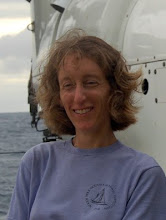
The photo at left shows Guam on the starboard horizon, as we were returning to land on Sept. 15th. After our gear was safely unloaded onto a flat-bed truck, Susan and I caught a bus with our colleagues to the Guam Hilton. We had the good fortune to relax for a day, including snorkeling in the warm clear waters, and then we had to say goodbye. In Japanese there are so many different ways to say goodbye, but I am hoping that we can say "Jaa, mata" (jahh-mah-tah), which is an informal way of saying "see you again." This cruise was an incredibly enriching experience - both scientifically and culturally. Susan and I look forward to working on our samples and data back at home in Woods Hole.
 |
| Tomomi Ogura |





























